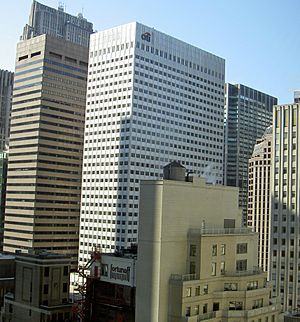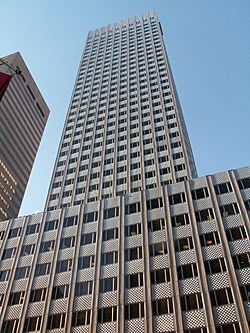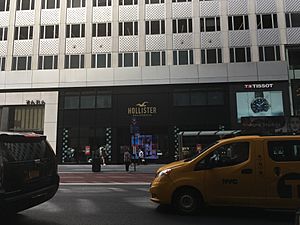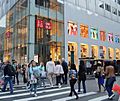666 Fifth Avenue facts for kids
Quick facts for kids 666 Fifth Avenue |
|
|---|---|
 |
|
| Former names | Tishman Building |
| General information | |
| Status | Complete |
| Type | Office |
| Location | 666 Fifth Avenue Manhattan, New York 10103 |
| Coordinates | 40°45′37″N 73°58′34″W / 40.760163°N 73.976204°W |
| Completed | 1957 |
| Opening | November 25, 1957 |
| Cost | $40 million |
| Owner | Brookfield Properties |
| Height | |
| Roof | 483 ft (147 m) |
| Technical details | |
| Floor count | 41 |
| Floor area | 1,463,892 sq ft (136,000.0 m2) |
| Lifts/elevators | 24 (20 passenger, 4 freight) |
| Design and construction | |
| Architect | Carson & Lundin |
| Developer | Tishman Realty and Construction |
666 Fifth Avenue is a tall, 41-story office building in New York City. It stands on Fifth Avenue in Midtown Manhattan, between 52nd and 53rd Streets. The building was designed by a company called Carson & Lundin and opened in 1957.
Over the years, 666 Fifth Avenue has had several different owners. The first owner, Tishman Realty and Construction, sold it in 1976. Later, it was bought by Sumitomo Realty & Development and then by Tishman Speyer. In 2007, Kushner Properties bought the building. Most recently, in 2018, Brookfield Properties took over the building with a long-term lease.
Contents
The Story of 666 Fifth Avenue
Building a Landmark: The Tishman Era
The Tishman family, through their company Tishman Realty and Construction, built this huge 1.5-million-square-foot (140,000 m2) office tower in 1957. It cost about $40 million to build. Before this building, the spot was home to fancy mansions. One was built in 1908 for the family of William Kissam Vanderbilt II. Another, the William K. Vanderbilt House, was a large castle-like home from 1882. Both were later taken down to make way for new buildings.
The architects, Carson & Lundin, also worked on another famous building nearby, 600 Fifth Avenue. The new building was first called the Tishman Building. A cool part of its design was the big "666" number on top. It also had special aluminum panels that were lit up by something called the "Tower of Light." Inside, the lobby featured unique sculptures by artist Isamu Noguchi. These included a "Landscape of the Cloud" design in the ceiling and a waterfall. On the top floor, there was a famous restaurant called Top of the Sixes, which closed in 1996.
The building officially opened on November 25, 1957. The mayor of New York City, Robert F. Wagner Jr., was there for the ceremony. Even before it opened, most of the office spaces were rented out. Companies like Warner Bros. and Revlon moved in. There was also a bank branch on the ground floor. For many years, the building had a special walk-through area with shops. This area connected 52nd Street, 53rd Street, and Fifth Avenue.
Changing Hands and New Looks
In 1976, the Tishman company sold the building for $80 million. Many different companies had offices there, and a fashion store, Ted Lapidus, was on the ground floor. In 1984, a small fire happened on the third floor, but everyone was safely evacuated.
In 1987, a Japanese company called Sumitomo Realty & Development bought 666 Fifth Avenue for $500 million. They made some changes, like turning the Top of the Sixes restaurant into a private cigar club.
In the 1990s, new businesses moved in. A law firm, Orrick, Herrington & Sutcliffe, rented several floors. In 1997, the National Basketball Association (NBA) opened its first-ever store at the base of the building. Brooks Brothers also opened a store there in 1998.
In 1999, Sumitomo spent $20 million to update the lobby and lower floors. They kept the special Noguchi artwork, fixing it up instead of removing it. They also changed the outside of the building, replacing aluminum panels with glass. This made the retail spaces more visible. After these updates, almost all the spaces in the tower were rented.
In 2000, Tishman Speyer Properties bought the building for $518 million. They enclosed the walk-through area, which meant the Fifth Avenue entrance was no longer open to the public.
A big change happened in 2002 when the "666" address sign was replaced with a Citigroup logo. Citigroup became the building's biggest tenant. Even though new rules usually don't allow such big signs, this one was allowed because the original "666" sign was there before the rules changed. Some people thought the new sign was too flashy.
Kushner Takes Over
In 2007, Kushner Properties bought the building for $1.8 billion. At the time, this was the highest price ever paid for a single building in Manhattan! This was a big step for Kushner Companies, which usually focused on smaller properties. Jared Kushner, who was 26 years old, took charge of the company and wanted to make a name for it in Manhattan. He even moved the company's main office into 666 Fifth Avenue.
The sale was unusual because the building wasn't officially for sale. Jared Kushner was very determined to buy it. He offered a high price to make sure his company got the building. The deal was completed very quickly, in less than a week.
Challenges and New Tenants
When the financial crisis of 2007–2008 hit, the building faced some challenges. In 2007, Citigroup decided not to renew some of its office space. Later, Kushner sold a part of the retail section of the building to another group for $525 million. This helped them pay off some loans. The new retail owners also paid Brooks Brothers and Hickey Freeman to close their stores early.
In 2010, the building had trouble paying its mortgage. But then, good news came! A Japanese clothing company called Uniqlo signed a huge 15-year lease for a large space at the base of the building. This became their new main store on Fifth Avenue. It was the biggest retail space on Fifth Avenue that wasn't a department store. The Uniqlo store opened in October 2011 with a big celebration.
After the Uniqlo deal, the retail space was put up for sale again. In 2011, Zara bought a large space for $324 million, setting a new record for a U.S. retail property. They planned to spend even more to update the space. Another company, Swatch, also rented retail space.
By 2010, the building was valued at much less than what Kushner Companies had paid for it. In 2011, Vornado Realty Trust bought a large share of the building. Kushner also agreed to invest more money to rent out the empty spaces. The lenders also agreed to reduce the loan amount and lower the interest rate.
In 2012, Vornado bought the rest of the retail space from Carlyle. More law firms and companies continued to lease office space in the building.
Looking for Investors and Future Plans
From 2014 to 2016, Kushner Companies looked for new investors for the property. They talked with wealthy individuals and investment funds from different countries. However, none of these deals were completed. The building lost money in 2015 and 2016, and it was only about 70% rented, which was lower than other office buildings in Manhattan.
There were plans to completely change the building. Architects designed a huge, very tall skyscraper that would replace the current building. The idea was to strip the building down to its steel frame and add many more stories on top. The new building would have a "vertical mall," a hotel, and luxury apartments. The developers even planned to change the name to 660 Fifth Avenue to avoid the number "666." However, these plans were eventually dropped because they couldn't find enough partners or lenders.
In 2017, the building continued to lose money as its loan interest rate increased. By early 2018, Vornado Realty Trust, which owned nearly half of the tower, decided to sell its share. Kushner then bought Vornado's share for $120 million.
Brookfield Properties Takes Over
In August 2018, Brookfield Properties signed a 99-year lease for 666 Fifth Avenue. This meant they effectively took full control of the building. Brookfield paid $1.286 billion for the property. They planned to invest more than $600 million to completely update the building. This included a new lobby, a new outside look, and new systems inside.
In 2019, Brookfield announced plans to officially rename the building 660 Fifth Avenue. They also shared plans for a $400 million renovation starting in late 2020. The new design would make the inside more open, add outdoor terraces, and replace the old aluminum outside with floor-to-ceiling windows. After the renovations, which are expected to finish in 2023, Brookfield hopes to rent out spaces at very high prices.
In 2020, Kushner Companies announced they would move their main office out of the building. Brookfield also paid other tenants to leave early so they could begin the big renovation project.
Tenants
Over the years, many different businesses have called 666 Fifth Avenue home.
- The first ground-floor stores included Brooks Brothers and the NBA Store. Both of these stores later moved out.
- The Grand Havana Room, a private club, is located on the top floor.
- The Hollister Co. flagship store opened in 2010. It features a live video feed from Huntington Beach, California, shown on many flat-screen TVs outside.
- Uniqlo occupies a large space on the ground, second, and third floors.
- Many law firms have offices in the building, including Schiff Hardin, Vinson & Elkins, and Akerman LLP.
- Other companies like the hedge fund Atlantic Investment Management and the private equity firm AEA Investors also have offices here.
- DC Comics and Doubleday (a book publisher) used to have their headquarters at 666 Fifth Avenue before moving to other locations.
- Former tenants also include law firms Orrick, Herrington & Sutcliffe and Norton Rose Fulbright, and investment firms Millennium Management, LLC and William Blair & Company.
Subway Entrance
The building has a direct entrance to the New York City Subway's Fifth Avenue/53rd Street station. This station is served by the E and M train subway line. When the Hollister Co. store opened, changes were made to the lobby and the subway entrance.
Images for kids
See also
 In Spanish: 666 Fifth Avenue para niños
In Spanish: 666 Fifth Avenue para niños









